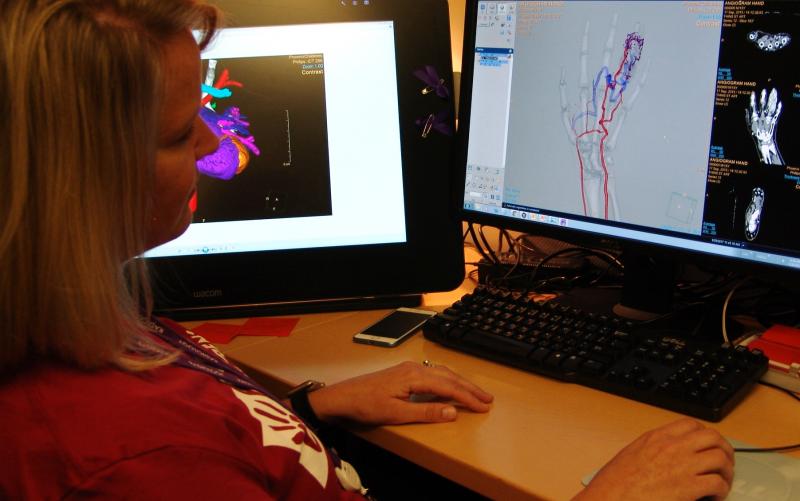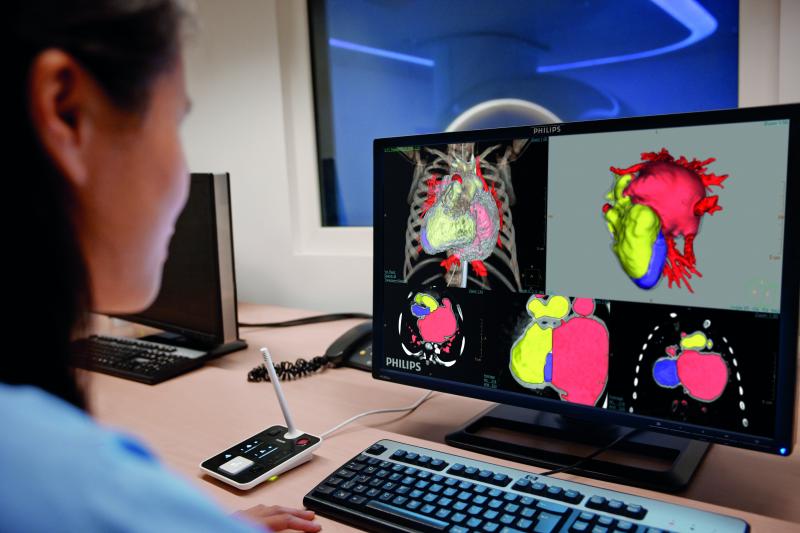
Greg Freiherr has reported on developments in radiology since 1983. He runs the consulting service, The Freiherr Group.
Phoenix Children's Hospital Uses Post-processing to Improve Care Quality and Efficiency

Robyn Augustyn displays an arteriovenous malformation that was fixed interventionally on the basis of a volume rendering created using Philips' IntelliSpace Portal at Phoenix Children's Hospital. (Photo courtesy of Greg Freiherr)
The teenager's chest was caved in. The underlying congenital flaw had gotten so bad that the sternum was almost pressing against the spine. Surgery at Phoenix Children's Hospital (PCH) in Phoenix saved the boy's life. A three-dimensional volume rendering of his chest paved the way. With it, the surgical team at PCH planned the operation.
Driving construction of that model was Philips IntelliSpace Portal, said William Barta, administrative director of imaging services at Phoenix Children’s Hospital. Although its most advanced functions are performed by staff in the PCH Post-Processing Lab, the IntelliSpace Portal is available to technologists and physicians throughout the hospital. The majority of post-processed cases involve trauma, which is hardly surprising given that PCH is a tertiary trauma center for children.
Staff in the Post-Processing Lab review a half dozen cases when they come in around 7 a.m., according to Robyn Augustyn, one of the two 3-D technologists working there. "We will look at what technologists did the night before," Augustyn said. "If there is additional post-processing, we can do that."
Tweaking might involve removing from the volume rendering the lower segment of a badly fractured ankle, for example, so the radiologist can better see the fracture planes, she said. The rest of the day Augustyn and her colleague might spend working on a handful of complex cases. Some are scheduled, but many come in as emergencies. These, along with the early morning reviews, amount to dozens of volumetric models generated each day, according to Barta.
How IntelliSpace Portal Works
The digital reconstruction begins when IntelliSpace Portal is used to access CT, MR or PET/CT data. The 2-D slices are reassembled in three dimensions. About 70 percent is in cardiology; 20 percent is in angiography, Augustyn said.
Hearts can be especially tricky. Congenital defects change blood flow in unexpected ways. "A lot of the connections aren't as they are supposed to be," she said.
The lab staff, which are charged with color coding the flow, have to get it right, or the physician could misinterpret the images. Red and blue show normal flow in opposite directions; green or purple indicate abnormal flow or vascular pathology.
Previously lead techs, Augustyn in CT and her colleague in MR, work as a team. "The IntelliSpace Portal gives us the ability to fuse our work together," she said. "If you want to do complex analysis, you need the IntelliSpace Portal."
One such case involved an arteriovenous malformation (AVM) that had caused a 15-year-old boy's finger to balloon painfully. "It was about twice normal size and would've kept getting bigger," Augustyn said. The volume-rendered model, created from CT data, showed the AVM and its surrounding cloud of vasculature in purple. Plugs for the blood vessels that fed the AVM were sized exactly in the model and the AVM was fixed during a minimally invasive intervention.
"Our measurements were spot on," she said. "They made a huge difference in this case."
The vast majority of 3-D reconstructions go no further than volume rendering. But about one in 10 are transformed into physical models using a 3-D printer in a separate PCH lab. Printed models often are of premature hearts. Barta recalls one case in which the cardiac surgeon, before surgery "sat with the model and wiggled (an implantable) device around to see how it would lay in the chest cavity."
If pre-surgical models are printed, so are post-surgical ones. Both are reviewed with patients and their parents "to show that the heart has been fixed," Barta said.
3-D Mindset
The argument used to be that 3-D reconstructions were a waste — that radiologists turn 2-D slices into 3-D in their heads, said Barta, whose career in medical imaging spans nearly four decades: "But the work we've done here has convinced me that post-processing, at least in our practice, is indispensable."
And the advantages go beyond simple modeling. Just as interventionalists have exactly sized plugs to stem abnormal blood flow, spine surgeons have used volume-rendered models to assess scoliosis and underdeveloped joints. And oncologists have made precise volumetric calculations of tumors based on IntelliSpace Portal reconstructions, allowing them to determine the efficacy of cancer treatments as much as a week after their start, according to Barta. The Post-Processing Lab has improved the quality in care and efficiency in the radiology department, he said.
Revenue is up, thanks to operating rooms and interventional suites that are used more efficiently. Volume-rendered models allow more surgeries and interventions, Barta explained. Portal-developed models also free physicians to interpret more studies and see more patients, which further boosts the bottom line.
A Matter of Faith
Winning approval to implement the lab, however, was challenging. Its development couldn't be justified on financial reimbursements for 3-D reconstructions alone. Although limited, Barta included them in his pitch to the C-Suite — along with projections of added revenue, projections that have since been proven.
"The lab allows money to be made in different places," Barta said. Added revenues, tracked at PCH, are used to validate the lab's budget.
Two years since its beginning, the PCH Post-Processing Lab is solidly in the black, even though its staff are paid more than they were as CT and MR technologists. "This is probably one of the most significant developments in terms of quality medicine," said Barta, who puts post processing with the IntelliSpace Portal in a class with the advent of CT and MRI.
Today the lab — and its engine, the IntelliSpace Portal — have positioned PCH for the future of medicine, when value replaces volume — a future that is patient centric, quality intensive and cost sensitive.
With the Post-Processing Lab at the ready, Barta said, administrators at the Phoenix hospital would like to see that future as soon as possible.
*Results from case studies are not predictive of results in other cases. Results in other cases may vary.



 April 22, 2024
April 22, 2024 








